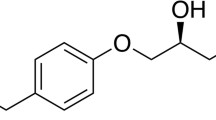Abstract
To obtain the standard compounds of metoprolol for a pharmacokinetic study, a convenient synthetic procedure to prepare enantiomers of metoprolol (3a) and its major metaboites, 2-4-(2-hydroxy-3-isopropylamino)propoxyphenylethanol (3b) and 4-(2-hydroxy-3-isopropylamino) pro-poxyphenylacetic acid (4), was developed from their respective starting materials, 4-(2-methoxyethyl)phenol (1a), 4-(2-hydroxyethyl)phenol (1b) and methyl 4-hydroxyphenylacetate (1c). These phenolic compounds (1a, b, c) were convertedin situ to their corresponding phenoxides with sodium hydroxide treatment followed by (R)- or (S)-epichlorohydrin treatment. The resulting epoxides2 were transformed to3 through reaction with isopropylamine. Ester3c was hydrolyzed to the metabolite4. Measured using the HPLC method on chiral column without any derivatization, the optical purity of enantiomers of metoprolol and o-demethylated metabolite3b ranged between 96–99% ee and that of enantiomers of carboxylic acid metabolite4 ranged 91% ee.
Similar content being viewed by others
References
Borg, K. O., Carlsson, E., Hoffmann, K. J., Jonsson, T. E., Thorin, H. and Wallin, B., Metabolism of metoprolol-[3H] in man, the dog and the rat.Acta Pharmacol. Toxicol., 36, 125–35 (1975).
Chiu, F. C., Damani, L. A., Li, R. C. and Tomlinson, B., Efficient high-performance liquid chromatographic assay for the simultaneous determination of metoprolol and two main metabolites in human urine by solid-phase extraction and fluorescence detection.J. Chromatogr. B, 696, 69–74 (1997).
Gurjar, M. K., Sadalapure, K., Adhikari, S., Sarma, B. V. N. B. S., Talukdar, A. and Chorghade, M. S., Kinetic Resolution of Aryl Glycidyl Ethers: a Practical Synthesis of Optically Pure β-Blocker-S-metoprolol.Heterocycles, 48, 1471–6 (1998).
Iseki, K., Oishi, S., Sasai, H. and Shibasaki, M., Synthesis and biological evaluation of a fluorinated analog of the β-adrenergic blocking agent, metoprolol.Bioorganic & medicinal chem. letters, 7, 1273–4 (1997).
Johnsson, G. and Regardh, C. G., Clinical pharmacokinetics of β-adrenoreceptor blocking drugs.Clin. Pharmacokinet., 1 (4), 233–63 (1976).
Kai, T., Isami, T., Kobata, K., Kurosaki, Y., Nakayama, T. and Kimura, T., Keratinized epithelial transport of β-blocking agents. I. Relationship between physicochemical properties of drugs and the flux across rat skin and hamster cheek pouch.Chem Pharm Bull., 40(9), 2498–504 (1992)
Keding, B. I., Lindqvist, B. A. R. and Samuelsson, B. B., Process for S-metoprolol via oxazolidin-2-one, U. S. Patent No. 5,034,535 (1991).
Li, F., Cooper, S. F. and Cote, M., Determination of the enantiomers of metoprolol and its major acidic metabolite in human urine by high-performance liquid chromatography with fluorescence detection.J. Chromatogr. B, 668(1), 67–75 (1995).
Matsuki, Y., Ito, T., Komatsu, S. and Nambara, T., Studies on the metabolism of atenolol. Characterization and determination of a new urinary metabolite in the rat.Chem. Pharm. Bull., 30(1), 196–201 (1982).
Murthy, S. S., Shetty, H. U., Nelson, W. L., Jackson, P. R. and Lennard, M. S., Enantioselective and diastereo-selective aspects of the oxidative metabolism of metoprolol.Biochem. Pharmacol. 40, 1637–44 (1990).
Nathanson, J. A., Stereospecificity of β-adrenergic antagonists: R-enantiomers show increased selectivity for β2-receptors in ciliary process.J. Pharmacol. Exp. Ther., 245(1), 94–101 (1988).
Phillips, G. T., Robertson, B. W. Bertola, M. A., Koger, H. S, Marx, A. F. and Watts, P. D., Process for producing 4-(2-methoxyethyl)-phenyl-glycidyl ether and/or metoprolol, U. S. Patent No. 4, 956, 284 (1990).
Sasai, H., Suzuki, T., Itoh, N. and Shibasaki, M., Catalytic Asymmetric Synthesis of Propranolol and Metoprolol Using a La-Li-BINOL Complex.Applied Organometallic Chemistry, 9(5), 421 (1995).
Shetty, H. U. and Nelson, W. L., Chemical aspects of metoprolol metabolism. Asymmetric synthesis and absolute configuration of the 3-[4-(1-hydroxy-2-methoxyethyl) phenoxy]-1-(isopropylamino)-2-propanols the diastereomeric benzylic hydroxylation metabolites.J. Med. Chem., 31(1), 55–9 (1988).
Author information
Authors and Affiliations
Corresponding author
Rights and permissions
About this article
Cite this article
Jung, SH., Pham Tuan Linh, Lim, HK. et al. Enantioselective preparation of metoprolol and its major metabolites. Arch Pharm Res 23, 226–229 (2000). https://doi.org/10.1007/BF02976449
Received:
Issue Date:
DOI: https://doi.org/10.1007/BF02976449



